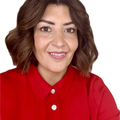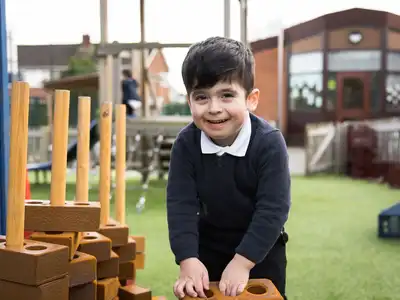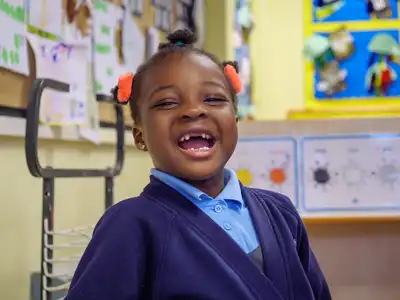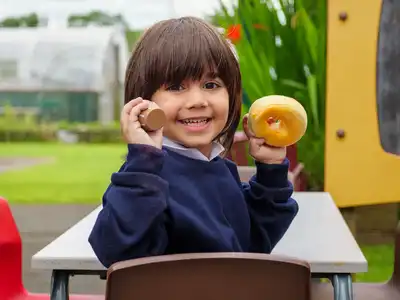How can early years settings put individual children at the heart of their practice? Two expert practitioners describe how getting to know the unique child and responding to insight on whole-class needs means they can meet children’s needs from the start.
Why we want to understand the unique child
Ashby Hill Top Primary School is a one-and-a-half-form-entry mainstream primary school in a market town in Leicestershire. Over recent years we have seen a change in the make-up of our school community which has had an impact on our children’s start to school. Every new early years cohort looked different, from factors like cultural heritage and special education needs and disabilities, to pre-school experience and each child’s developmental journey.
What had been successful in settling one cohort wasn’t necessarily going to work with the next.
We wanted to get it right for each child and family from the start. We wanted first impressions to be positive ones that we could build on through trusting relationships. We also wanted to create a supportive learning classroom tailored to each child’s needs.
Our thorough induction programme always gave us comprehensive information, but we weren’t using this effectively to shape what’s available in the classroom at the beginning of the year.
Over the last two years we have reflected more deeply on what we can learn about each child’s journey, and how we can use this to be more adaptive and responsive in our practice to meet their needs from the start.
This case study is part of a series exploring the four overarching principles of the early years foundation stage: the unique child, positive relationships, enabling environments, and learning and development.
How we learn about the unique child
Our new induction processes are a whole-school priority, and we get information on each child in the incoming group in three ways.
Early years staff visit children at home and in their current setting before they enter the classroom. These observations provide vital information about how each child learns such as:
- Where they choose to play.
- How they play and for how long.
- What their interactions are like.
- What their language skills are like.
- What their interests are.
By reflecting on these key areas, we gather lots of information about children as learners – how they explore, stay motivated, and think critically – to build a picture of their development, as well as what they know and can do.
Children visit our setting five times during the summer term before they start school. Practitioners observe the children carefully to get insights into how they will engage with the learning environment, which areas are popular with this group of children, and which are not drawing their interest.
How we get information about children early on
We invest time early on to get information and build relationships with families. Class teachers have the information and time they need to reflect on each child. This helps them meet individual children’s needs within the overall classroom offer and to make initial judgements about the whole cohort.
This led to significant changes to both the learning environment and the starting points for teaching and learning. For example, one year the overall information showed that the cohort had weaker gross and fine motor development.
We researched what adaptations would best support their needs and we developed new classroom spaces in response. This included a separate Doodle Den with a focus on pre-writing skills; a vertical mark-making space including a ladder to strengthen children’s core, shoulder and arm muscles; and developing the outdoor area to include climbing and digging.
These were all in place for the children’s first full day at school. We then observed children’s sustained play and made refinements to ensure we were meeting their needs within the first few weeks of school.
Each year we make a similar level of change based on what we know about the new children.
How we trust expertise above traditional approaches
The view that staff in early years should concentrate on teaching their planned curriculum alongside on-entry assessments within the first two or three weeks has not worked for us. Instead, our staff focus on in-depth observations and quality interactions that give us a clear understanding of the starting points for teaching and learning.
We use Ferre Laevers’ Leuven Scales of emotional wellbeing and involvement (1994) to understand how a child is feeling and how engaged they are in activities. This helps us to understand children’s needs and ensure we are meeting them. On-entry assessments complement this approach, but we don’t start teaching curriculum content until we are sure that the children are ready.
Sometimes children have needed us to go slow to be able to go fast. When this happens, we spend more time building routines and trusting relationships, developing children’s involvement levels through sustained periods of co-play. School leaders fully support our approach and trust our expert practitioners to act in the best interests of the children.
How our approach benefits children and families
Our new child-centred approach to the start of the school year helps children and families feel less anxious. Children come into a classroom that we have shaped around their interests and development, which builds their confidence and helps them separate from caregivers easily.
Because the early years team builds a shared understanding of each child from the outset, we can respond quickly to emotional cues. As a result, children get involved and have good wellbeing very early in the term.
We design the learning environment so that learning begins immediately through the experiences we offer. When the time is right, we introduce more direct teaching, using what we have learned from watching, talking with, and thinking about the children.
By investing time before the summer holidays to understand each new group of children, we make what we offer responsive from day one. This preparation leads to a smooth transition into school and improves pupils’ outcomes across the year. Our school’s results are consistently above the national good level of development of 67%.
For handy tips and reflective questions about the unique child, school and early years leaders can read our understanding the unique child blog.




